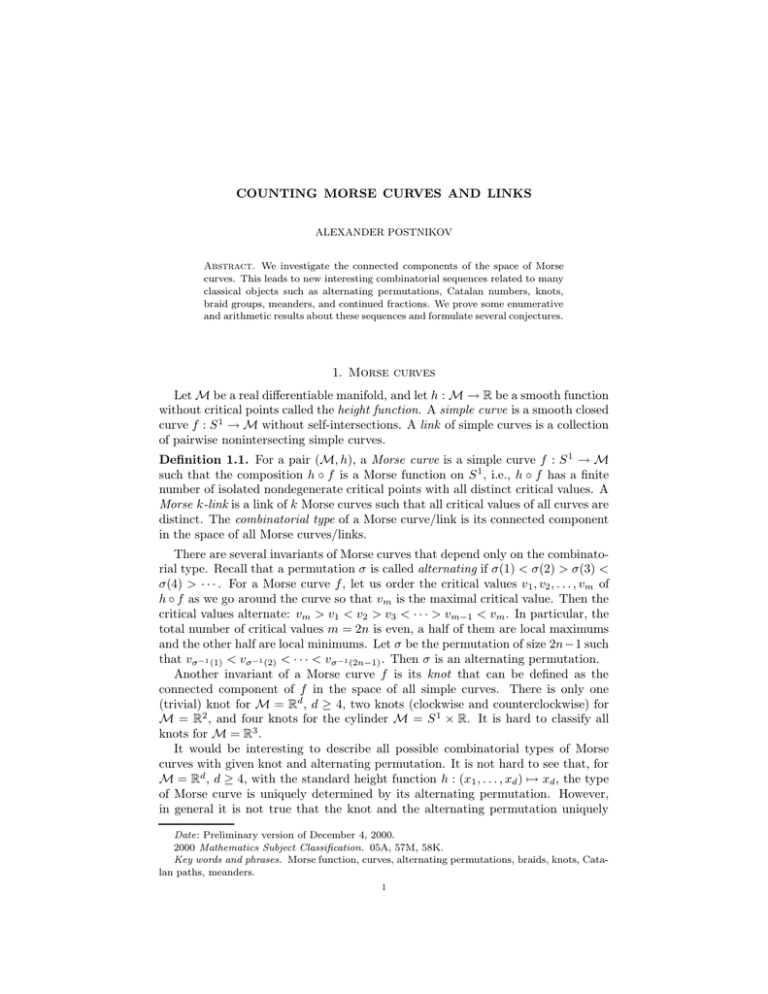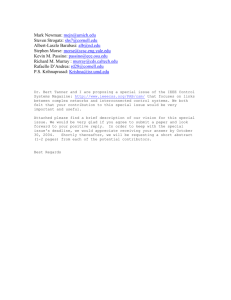COUNTING MORSE CURVES AND LINKS
advertisement

COUNTING MORSE CURVES AND LINKS
ALEXANDER POSTNIKOV
Abstract. We investigate the connected components of the space of Morse
curves. This leads to new interesting combinatorial sequences related to many
classical objects such as alternating permutations, Catalan numbers, knots,
braid groups, meanders, and continued fractions. We prove some enumerative
and arithmetic results about these sequences and formulate several conjectures.
1. Morse curves
Let M be a real differentiable manifold, and let h : M → R be a smooth function
without critical points called the height function. A simple curve is a smooth closed
curve f : S 1 → M without self-intersections. A link of simple curves is a collection
of pairwise nonintersecting simple curves.
Definition 1.1. For a pair (M, h), a Morse curve is a simple curve f : S 1 → M
such that the composition h ◦ f is a Morse function on S 1 , i.e., h ◦ f has a finite
number of isolated nondegenerate critical points with all distinct critical values. A
Morse k-link is a link of k Morse curves such that all critical values of all curves are
distinct. The combinatorial type of a Morse curve/link is its connected component
in the space of all Morse curves/links.
There are several invariants of Morse curves that depend only on the combinatorial type. Recall that a permutation σ is called alternating if σ(1) < σ(2) > σ(3) <
σ(4) > · · · . For a Morse curve f , let us order the critical values v1 , v2 , . . . , vm of
h ◦ f as we go around the curve so that vm is the maximal critical value. Then the
critical values alternate: vm > v1 < v2 > v3 < · · · > vm−1 < vm . In particular, the
total number of critical values m = 2n is even, a half of them are local maximums
and the other half are local minimums. Let σ be the permutation of size 2n−1 such
that vσ−1 (1) < vσ−1 (2) < · · · < vσ−1 (2n−1) . Then σ is an alternating permutation.
Another invariant of a Morse curve f is its knot that can be defined as the
connected component of f in the space of all simple curves. There is only one
(trivial) knot for M = Rd , d ≥ 4, two knots (clockwise and counterclockwise) for
M = R2 , and four knots for the cylinder M = S 1 × R. It is hard to classify all
knots for M = R3 .
It would be interesting to describe all possible combinatorial types of Morse
curves with given knot and alternating permutation. It is not hard to see that, for
M = Rd , d ≥ 4, with the standard height function h : (x1 , . . . , xd ) 7→ xd , the type
of Morse curve is uniquely determined by its alternating permutation. However,
in general it is not true that the knot and the alternating permutation uniquely
Date: Preliminary version of December 4, 2000.
2000 Mathematics Subject Classification. 05A, 57M, 58K.
Key words and phrases. Morse function, curves, alternating permutations, braids, knots, Catalan paths, meanders.
1
2
ALEXANDER POSTNIKOV
determine the type of a Morse curve. Figure 1 shows two Morse curves in R3 of
different types (with respect to the standard height function). They have the same
(trivial) knot and the same alternating permutation.
Figure 1. Two Morse curves in R3 of different types with the
same knot and the same alternating permutation
In this article, we will concentrate on 2-dimensional manifolds M.
2. Plane Morse curves and links
Definition 2.1. A plane Morse curve is a Morse curve on M = R2 oriented
clockwise with the height function h : (x, y) 7→ y. A plane Morse k-link as a Morse
link of k such curves (all oriented clockwise). The order of a curve/link is half the
total number of its critical points.
Figure 2 gives an example of plane Morse curve of order 11. There is one com-
Figure 2. A plane Morse curve of order 11
binatorial type of plane Morse curves of order 1 and four types of plane Morse
curves of order 2, see Figure 3. An example of Morse 6-link of order 10 is shown
on Figure 4. There are 6 combinatorial types of 2-links of order 2, see Figure 5.
Let Fn be the number of connected components of the space of plane Morse
(k)
curves of order n. Also let Ln be the the number of connected components of the
P (k)
space of plane Morse k-links of order n and Ln = k Ln be the total number of
components of the space of links of order n.
The first few numbers Fn and Ln are given in the following table.1
1The author wrote a C++ program for calculation the numbers L .
n
COUNTING MORSE CURVES AND LINKS
3
Figure 3. All plane Morse curves of orders 1 and 2
Figure 4. A plane Morse 6-link of order 10
Figure 5. All plane Morse 2-links of order 2
n
0 1
2
3
4
5
6
7
Fn
0 1
4
70
2752
191888
20860608
?
Ln
1 1 10 325 22150 2586250 461242900 116651486125
n
Ln
8
9
10
39713286199150 17511670912894750 9709015945443877900
4
ALEXANDER POSTNIKOV
Define the n-th link polynomial Ln (q) as the generating function for k-link numbers of order n:
X
k
L(k)
Ln (q) =
n q
k
It is clear that Fn is the coefficient of q in Ln (q) and Ln = Ln (1). The first few
polynomials Ln (q) are the following
L0 (q) = 1 ,
L1 (q) = q ,
L2 (q) = 4 q + 6 q 2 ,
L3 (q) = 70 q + 160 q 2 + 95 q 3 ,
L4 (q) = 2752 q + 8198 q 2 + 8316 q 3 + 2884 q 4 ,
L5 (q) = 191888 q + 695312 q 2 + 958698 q 3 + 597792 q 4 + 142560 q 5 ,
L6 (q) = 20860608 q + 88459928 q 2 + 151680336 q 3 + 131749186 q 4+
+ 58080440 q 5 + 10412402 q 6 .
Theorem 2.2. The numbers Ln are the coefficients of the expansion of the continued fraction
X
1
= 1 + x + 10 x2 + 325 x3 + · · · =
L n xn .
2
1 x
n≥0
1−
32 x
1−
52 x
1−
72 x
1−
1 − ···
2n
1
equals the number of Catalan
Recall that the Catalan number Cn = n+1
n
path, which are lattice paths from (0, 0) to (2n, 0) with steps (1, 1) (up step) and
(1, −1) (down step) that always stay in the upper halfplane {(x, y) | y ≥ 0}. Let us
say that an up step (i, j − 1) → (i + 1, j) and a down step or (i, j) → (i + 1, j − 1) in
a Catalan path has level j. Let us fix two infinite sets of parameters u1 , u2 , u3 , . . .
and d1 , d2 , d3 , . . . and weight each up step of level j by uj and each down step of
level j by dj . Then define the weight wt(P ) of a Catalan number as the product of
weights of all its steps. It is well-known the generating series of weighted Catalan
paths is given by the following continued fraction; see [GJ]:
X
X
1
wt(P ) xn =
.
u1 d 1 x
n≥0 P :(0,0)→(2n,0)
1−
u2 d 2 x
1−
u3 d 3 x
1−
1 − ···
Proof of Theorem 2.2. Let us extablish a bijection between plane Morse links of
degree n and weighted Catalan paths with weights uj = dj = 2j − 1. Let us totally
order all 2n critical points of a Morse link so that their critical values increase. Let
us constract a Catalan path whose steps correspond to the critical points of the link.
COUNTING MORSE CURVES AND LINKS
5
More presicely, up steps correspond local minimums and down steps correspond to
maximums. For example, the link shown on Figure 4 gives the Catalan path with
the following sequence of up and down steps:
(U, U, U, U, D, D, D, U, D, U, U, D, U, D, D, U, U, D, D, D).
A step of level j in the Catalan path correspond a critial point p in the link such
that there are exactly 2j − 1 points in the link with the same height h(p) as p. Let
us count the number of combinatorial types of plane Morse links that produce a
given Catalan path. As we construct such a link by inserting critical points one by
one from the botton to the top, we have 2j − 1 options to insert a local minimum
or local maximum associated with a step of level j in the Catalan path. This gives
a correspondence between weighted Catalan paths and Morse links.
Theorem 2.3. The value (−1)n Ln (−1) is equal to the n-th Catalan number:
1
2n
n
(−1) Ln (−1) = Cn =
.
n+1 n
Proof. Let us say that a critial point p in a plane Morse link is left-movable if the
number of (non-critical) points on the link to the left of p with the same height
h(p) is odd. Also say that a critial point p in a plane Morse link is right-movable if
it is not left-movable, i.e., there are even number of points on the link to the left
of p with the same height h(p), and there is at least one such point to the right of
p. Let us use the Involution Principle to show that the alternating sum of plane
Morse links with at least one left- or right-movable critical point is 0. Find the
left- or right-movable critical point p with the minimal critical value. Then replace
the local neighboringhood of the point p (together with its left or right neighboring
strand) as shown on Figure 6. The left-hand side of Figure 6 corresponds to a
left-movable point and the right-hand side corresponds to a right-movable point.
Note that, if we apply this operation twice, then we obtain a link of the same
combinatorial type as the original link. Also notice that this operation changes the
number of curves in a link by 1. Thus all contributions to Ln (−1) of links with
movable critical points cancel each other.
Figure 6. Involution on plane Morse links
If a link has no movable critial points then it is uniquely determined by the
Catalan path constructed in the proof of Theorem 2.2. For any Catalan path with
2n steps there is such a link. This link consists of n disjoint curves.
Let π be an alternating permutation of size 2n. An index k ∈ {2, . . . , 2n − 1} is
called interior for π if there are two indices i < k < j such that π(i) < π(k) < π(j).
Let int(π) the number of interior indices for π.
6
ALEXANDER POSTNIKOV
Theorem 2.4. We have
Ln =
X
2int(π) ,
π
where the sum is over all alternating permutations of length 2n.
3. Binary arithmetics
The numbers Ln does not seem to have simple factorization. Nevertheless, the
they have interesting arithmetic properties for modulo powers of primes. Note that
Theorem 2.3 implies that the numbers Ln = Ln (1) and Cn = ± Ln (−1) have the
same parity. Actually, a stronger property seems to be true.
For an nonzero integer number m, let d2 (m) denotes the maximal power of 2
that divides the number m.
Conjecture 3.1. For n ≥ 1, the maximal power of 2 that divides the number Ln
is equal to the maximal power of 2 that divides the Catalan number Cn :
d2 (Ln ) = d2 (Cn ).
We have verified this conjecture for n ≤ 100, 000 using a computer.
The maximal power d2 (Cn ) is given by the following Kummer’s theorem that
can be found in [D]. For an nonnegative integer number
m, let s(m) be the sum of
P
digits 0 + 1 + · · · in the binary expansion m = i≥0 i 2i , i ∈ {0, 1}.
Theorem 3.2. (Kummer) The maximal power of 2 that divides the Catalan number Cn is equal to
d2 (Cn ) = s(n + 1) − 1.
Thus the records of the sequence d2 (Cn ) are the numbers n = 2k − 2.
Theorem 3.3. The number Ln −Cn is always divisible by 8. Thus d2 (Ln ) = d2 (Cn )
provided d2 (Cn ) = 0, 1, or 2 (i.e., when the number n + 1 has less than four 1’s in
the binary expansion).
Proof. Use the fact that a2 − 1 = (a − 1)(a + 1) is always divisible by 8 for even
a.
Let Rn = (Ln − Cn )/2. For even n, the number Rn is equal to the number of
links of order n with even number of curves. For odd n, the number Rn is equal
to the number links of order n with odd number of curves. Conjecture 3.1 would
follow from the next conjecture.
For an infinite sequence α = (α0 , α1 , α2 , . . . ) of 0’s and 1’s, let tα (m) denote
the
k where the sequence α disagree with the binary expansion m =
P first index
i
2
,
∈
{0, 1}, i.e., 0 = α0 , . . . , k−1 = αk−1 , and k 6= αk .
i
i
i≥0
Conjecture 3.4. There is a unique infinite sequence of 0’s and 1’s
(α0 , α1 , α2 , . . . ) = (1, 0, 1, 0, 1, 0, 1, 0, 1, 1, 0, 0, 0, 1, 1, 0, 0, 0, 0, 1, . . .)
such that for any number n ≥ 2 we have
d2 (Rn ) = s(n) + tα (n − 2) + 1.
In particular, d2 (Rn ) = s(n) + d2 (n − 549719) + 1 for n 6≡ 549719 (mod 220 ).
We have verified this statement for n ≤ 100000.
Conjecture 3.4 implies the following two statements. Recall that a record of a
sequence An is an index r such that Ar > An for all n < r.
COUNTING MORSE CURVES AND LINKS
7
Theorem 3.5. Suppose that Conjecture 3.4 is true. Then there is an infinite
increasing sequence
a1 , a2 , a3 , · · · = 0, 2, 4, 6, 8, 9, 13, 14, 19, . . .
(ai is the position of the i-th 1 in the sequence α) such that the records of the
sequence d2 (Rn ), n ≥ 2, are exactly the numbers
rk = 2 +
k
X
2 ai .
i=1
There is a recursive procedure for finding the records rk .
Theorem 3.6. Suppose that Conjecture 3.4 is true. If n = rk is a record of
the sequence d2 (Rn ), then the next record is rk+1 = n + 2ak+1 , where ak+1 =
d2 (Ln ) − s(n) − 1.
We have verified that the first records of the sequence d2 (Rn ), n ≥ 2, are
given by this procedure. The records are 2, 3 = 2 + 12 , 7 = 2 + 1012 , 23 =
2 + 101012, 87 = 2 + 10101012, 343 = 2 + 1010101012, 855 = 2 + 11010101012,
9047 = 2 + 100011010101012, and 25431 = 2 + 1100011010101012. We have
d2 (R2 ) = 2, d2 (R3 ) = 5, d2 (R7 ) = 8, d2 (R23 ) = 11, d2 (R87 ) = 14, d2 (R343 ) = 16,
d2 (R855 ) = 21, d2 (R9047 ) = 23, and d2 (R25431 ) = 29. If Conjecture 3.4 is true the
next record is 549719 = 2 + 10000110001101010101 2.
4. Arithmetics modulo 3k and 5k
Conjecture 4.1. For any n, d3 (Ln + 2) = 1, d3 (Ln + 5) = 1, d3 (Ln + 8) = 2,
d3 (Ln + 11) = 1. For any even n ≥ 2, d3 (Ln − 1) = 2.
Theorem 4.2. 1. For any odd m, the sequence Ln (mod m) is periodic.
2. The sequence Ln ≡ 1 (mod 3) is periodic with period 1. The sequence Ln ≡ 1
(mod 32 ) is periodic with period 1. The sequence Ln (mod 33 ) is periodic with
period 2. The sequence Ln (mod 34 ) is periodic with period 6. The sequence Ln
(mod 35 ) is periodic with period 18. The sequence Ln (mod 36 ) is periodic with
period 54.
Conjecture 4.3. 1. The sequence Ln (mod 33+r ) is periodic with period 2 · 3r .
2. The sequence Ln (mod 7) is periodic with period 12.
3. The sequence Ln (mod 11) is periodic with period 55.
For an nonzero integer number m, let d5 (m) denotes the maximal power of 5
that divides the number
P m. Also let k(n) be the number k ≥ 0 such that in the
5-ary expansion n = i≥0 i 5i , 0 ≤ i ≤ 4, we have 0 = · · · = k−1 = 1, and
k 6= 1.
Conjecture 4.4. For n ≥ 4, we have
(
2
if n is even,
d5 (Ln ) =
k(n) · (n − 4) + 3 if n is odd.
Theorem 4.5. If Conjecture 4.4 is true, then the records of the sequence d 5 (Ln ),
n ≥ 5, are the numbers n = 4 + (52k − 1)/4, k = 0, 1, . . . .
We have verified Conjecture 4.5 for the numbers Ln with n ≤ 300. The first
records are 5 = 4 + 15 , 35 = 4 + 1115 , 785 = 4 + 111115, 4 + 11111115, etc.
8
ALEXANDER POSTNIKOV
5. Cylindric Morse curves
In this section we study Morse curves on the cylinder M = S 1 × R. The height
function h : S 1 × R → R is given by the projection to the second coordinate,
h : (x, y) → y.
Theorem 5.1. The number CLn of links of order n on the cylinder is equal to
2n · UD2n .
Theorem 5.2. The value (−1)n CLn (−1) is equal to 2n .
6. Meanders
Let Mn be the menadric number.
Theorem 6.1. We have Mn < Fn < M??? .
References
[A]
V. I. Arnold: The calculus of snakes and the combinatorics of Bernoulli, Euler and Springer
numbers of Coxeter groups, Russian Math. Surveys 47 (1992), 1–51.
[D] L. E. Dickson: History of the Theory of Numbers, three volumes, Carnegie Institute, Washington, DC, 1919–23; reprinted 1992.
[GJ] I. P. Goulden, D. M. Jackson: Combinatorial Enumeration, John Wiley, New York, 1983.
Department of Mathematics, University of California, Berkeley, CA 94720
E-mail address: apost@math.berkeley.edu
URL: http://www.math.berkeley.edu/~apost/





